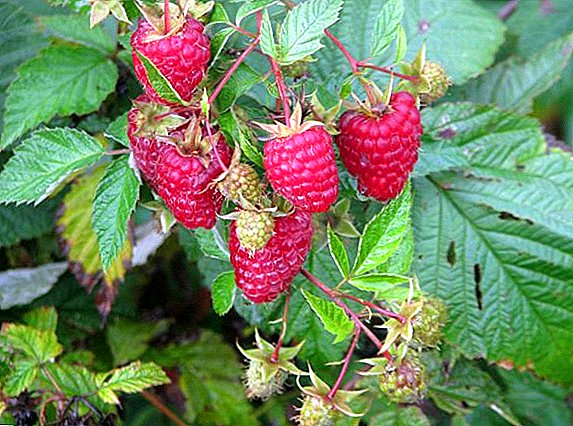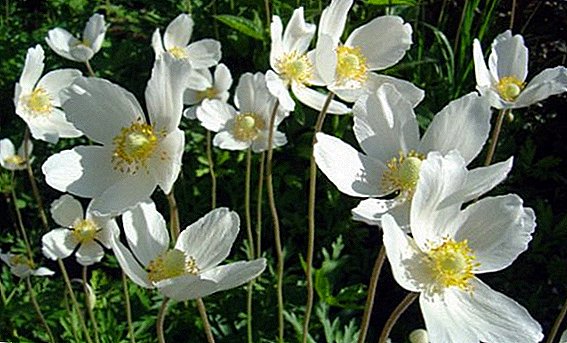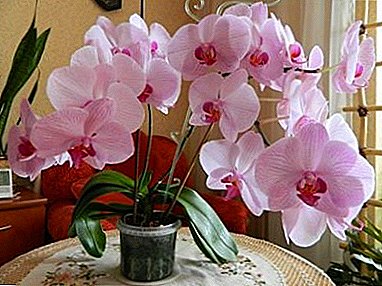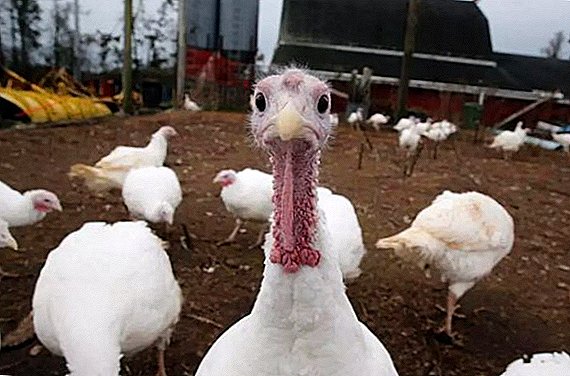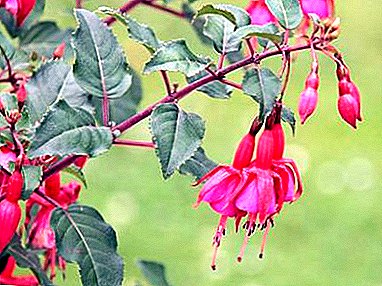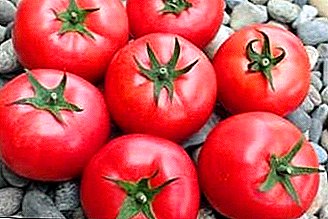
Pink fruit tomatoes are always a success. They are tasty, fleshy, have a delicate aroma and attractive appearance. These are the tomatoes of the variety “Gifts of the Volga region”. Compact plants are unpretentious, resistant to diseases and quite suitable for novice gardeners.
In the article we will tell about all the nuances with which you will have to face when growing and caring for this plant, as well as a crop of what magnitude you expect.
Tomatoes Gift of Trans-Volga: variety description
| Grade name | Gift of the Volga region |
| general description | Mid-season determinant variety |
| Originator | Russia |
| Ripening | 110-115 days |
| The form | Round with light ribbing |
| Colour | Pink |
| Average tomato mass | 75-110 grams |
| Application | Salad variety |
| Yield varieties | 5-7 kg per square meter |
| Features of growing | Agrotechnika standard |
| Disease resistance | Resistant to most diseases |
 "Gift of the Volga pink" - medium-early high-yielding variety. The bush is determinant, non-stem, moderately leafy. The height of an adult plant is 50-70 cm. The leaves are medium in size, simple, light green.
"Gift of the Volga pink" - medium-early high-yielding variety. The bush is determinant, non-stem, moderately leafy. The height of an adult plant is 50-70 cm. The leaves are medium in size, simple, light green.
The fruits ripen with brushes of 4-6 pieces. Productivity is good, from 1 square. m. landings can be removed about 5-7 kg of selected tomatoes, which is enough for a business to grow tomatoes in the greenhouse.
Medium sized fruits weighing from 75 to 110 g. Form rounded, with pronounced ribbing at the stem. The color of ripe tomatoes is deep pink. The flesh is juicy, moderately dense, fleshy, sugary at the break. The number of seed chambers varies from 3 to 6. The skin is thin, dull, protecting the fruit from cracking.
The taste is very pleasant, balanced, sweet, without wateriness. The high sugar content makes it possible to recommend tomatoes for baby food. The content of solids in the juice is more than 5%. Fruits are rich in amino acids, mineral salts, lycopene and beta carotene.
And you can compare the weight of the fruits of this variety with other varieties in the table:
| Grade name | Fruit weight |
| Gift Volga Pink | 75-110 grams |
| Grapefruit | 600-1000 grams |
| Lazy man | 300-400 grams |
| Andromeda | 70-300 grams |
| Mazarin | 300-600 grams |
| Shuttle | 50-60 grams |
| Yamal | 110-115 grams |
| Katya | 120-130 grams |
| Early love | 85-95 grams |
| Black moor | 50 grams |
| Persimmon | 350-400 |
 Read also interesting articles about planting tomatoes in the garden: how to properly tying and mulching?
Read also interesting articles about planting tomatoes in the garden: how to properly tying and mulching?How to build a mini-greenhouse for seedlings and use growth promoters?
Specifications
The variety of tomato “Dar Zavolzhya pink” was bred by Russian breeders, zoned for areas with a temperate climate. The grade showed good productivity in the Central Black Earth, Central, North Caucasus, Nizhnevolzhsky districts.
Cultivation in open beds or under film is recommended; planting in a greenhouse is practiced in the northern regions. Tomatoes are well kept, suitable for transportation. The variety is great for commercial cultivation and sale. Fruits can be picked green, they ripen successfully at room temperature.
Fruits of the variety "Gift of the Volga pink" refer to the salad type. They are tasty fresh, suitable for preparing snacks, side dishes, soups, sauces, mashed potatoes and pastes. Ripe tomatoes make a delicious thick juice of a pleasant pink color. Tomatoes can be preserved: pickle, pickle, include vegetable mixes.
Pink tomatoes are suitable for people who do not tolerate the traditional red fruit due to allergic reactions.
Advantages and disadvantages
Among the main advantages of the variety:
- early amicable ripening;
- high taste of fruits;
- good yield;
- leveled tomatoes are well suited for sale;
- ripe tomatoes do not crack and do not deform;
- resistance to major diseases.
There are practically no flaws in the variety. For successful fruiting need frequent feeding and attentive watering.
And you can compare its yield with other varieties in the table:
| Grade name | Yield |
| Gift Volga Pink | 5-7 kg per square meter |
| Tanya | 4.5-5 kg per square meter |
| Alpatyeva 905 A | 2 kg from a bush |
| Dimensionless | 6-7,5 kg from a bush |
| Pink honey | 6 kg from a bush |
| Ultra early | 5 kg per square meter |
| Riddle | 20-22 kg per square meter |
| Wonder of the earth | 12-20 kg per square meter |
| Honey Cream | 4 kg per square meter |
| Red dome | 17 kg per square meter |
| King early | 10-12 kg per square meter |
Features of growing
 Tomatoes varieties "Dar Zavolzhye" can be grown seedling or seedless. Seedlings are sown in seedlings in the second half of March. Pretreatment with a growth stimulator or freshly squeezed aloe juice is recommended. The soil for seedlings is made up of a mixture of garden soil with humus or peat. A small portion of washed river sand will help to lighten the substrate; it can be made more nutritious by adding wood ash or superphosphate.
Tomatoes varieties "Dar Zavolzhye" can be grown seedling or seedless. Seedlings are sown in seedlings in the second half of March. Pretreatment with a growth stimulator or freshly squeezed aloe juice is recommended. The soil for seedlings is made up of a mixture of garden soil with humus or peat. A small portion of washed river sand will help to lighten the substrate; it can be made more nutritious by adding wood ash or superphosphate.
Read more about the soil for seedlings and for adult plants in greenhouses. We will tell you about what types of soil for tomatoes exist, how to prepare the right soil on your own and how to prepare the soil in the greenhouse in spring for planting.
Seeds are sown with minimal penetration, sprinkled with peat and sprayed with water. The container with crops is located in heat before emergence of shoots. Young tomatoes are placed on the window sill of the south window or under fluorescent lamps. Watering them should be moderate, only warm water. After the appearance of the first pair of true leaves, the saplings dive.
Young plants are fed liquid complex fertilizer. The second feeding will take place immediately before disembarking for permanent residence. At the age of 30 days, the seedlings are hardened, bringing to fresh air, first for several hours and then for the whole day. Transplantation to the beds begins in the second half of May and early June, when the soil warms up completely. On 1 square. m. can accommodate 3-4 bush.
It is desirable to plant tomatoes in the ground, which was occupied by legumes, cabbage, carrots or lettuce. You can not use the beds, which grew solanaceae: other varieties of tomatoes, eggplant, peppers. Before planting, the earth is carefully loosened and fertilized with a generous portion of humus. Young tomatoes after transplantation is recommended to cover the film. Watering plants should be moderate, waiting for the drying of the top layer of soil. Only warm, soft water is used; from a cold plant they can shed ovaries.
Every 2 weeks, tomatoes are fed, alternating mineral complexes and organic fertilizers (diluted mullein or bird droppings). Nitrogen-containing complexes after flowering is not used, replacing them with compounds with a predominance of potassium and phosphorus. Once a season, foliar feeding is carried out with an aqueous solution of superphosphate..
Compact bushes do not need to be formed, but for better access of the sun and air to the fruits, the lower leaves can be removed. It is recommended to tie heavy branches with fruits to the support. About the ways of garter tomatoes in the greenhouse, we will tell here.
Diseases and pests
Tomatoes "Gift Zavolzhya pink" resistant to many typical diseases of the nightshade. They are not afraid of tobacco mosaic, fusarium or verticillus wilt, leaf spot. From the epidemic of late blight tomatoes saves early ripening. For prevention, treatment with copper-containing preparations is recommended. Useful and spillage of the soil with an aqueous solution of copper sulphate before planting seedlings.
Young plants are regularly sprayed with phytosporin or a weak solution of potassium permanganate. Insect pests are destroyed with industrial insecticides. They are irreplaceable in case of a lesion with thrips, whitefly, spider mites.
Plantings are processed 2-3 times with an interval of several days. Instead of toxic compounds, you can use a decoction of celandine or onion peel. From the naked slugs helps an aqueous solution of ammonia. Aphids can be washed off with warm, soapy water. Large larvae and adult insects are harvested by hand and destroyed.
The variety of tomatoes “Gift of the Volga pink” is an excellent choice for home farms. The friendly ripening of fruits and bushes that do not require formation, make it suitable even for very busy gardeners. Minimal care guarantees a bountiful harvest; seeds for subsequent plantings can be harvested on their own.
| Late-ripening | Early maturing | Middle late |
| Bobcat | Black bunch | Golden Crimson Miracle |
| Russian size | Sweet bunch | Abakansky pink |
| King of Kings | Kostoroma | French grapevine |
| Long keeper | Buyan | Yellow banana |
| Grandma's Gift | Red bunch | Titanium |
| Podsinskoe miracle | The president | Slot |
| American ribbed | Summer resident | Krasnobay |


